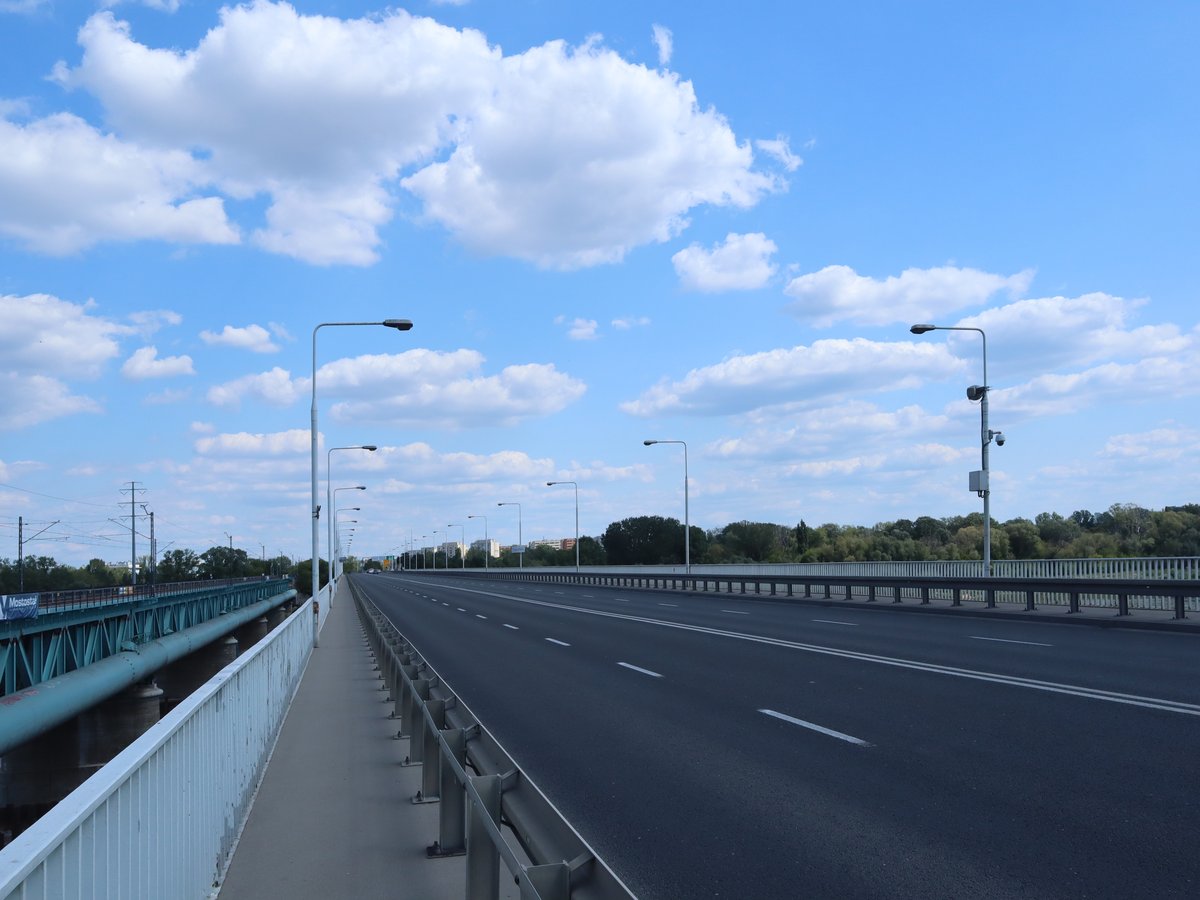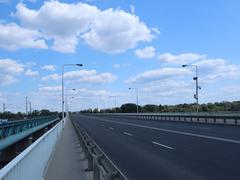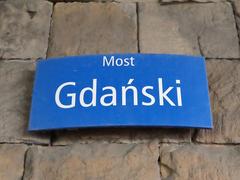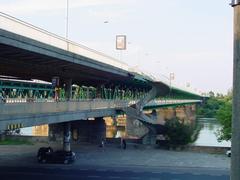
Gdański Bridge Visiting Hours, Tickets, and Guide to Warsaw Historical Sites
Date: 14/06/2025
Introduction
The Gdański Bridge (Most Gdański) stands as a symbol of Warsaw’s resilience, innovation, and cultural vibrancy. Spanning the Vistula River, it connects the historic heart of the city—encompassing the Old Town and New Town—with the dynamic Praga Północ district. This double-decker steel truss bridge is not just an essential transportation artery; it is also a testament to Warsaw’s layered history and architectural ingenuity. Whether you are a history enthusiast, architecture aficionado, or casual traveler, the Gdański Bridge offers a multifaceted experience, blending panoramic cityscapes, access to cultural attractions, and a living link to Warsaw’s past and present (Wikipedia; Warsaw City Tours; Warsaw Insider).
Table of Contents
- Introduction
- Historical Overview
- Architectural Features and Significance
- The Bridge’s Role in Modern Warsaw
- Visiting Gdański Bridge
- Cultural and Social Importance
- Maintenance and Modernization
- Practical Tips
- Frequently Asked Questions (FAQ)
- Conclusion
- Images and Media
- Related Resources
Historical Overview
Origins and Early Development
The origins of Gdański Bridge date back to the late 19th century, with the construction of the Citadel Rail Bridge (Most Cytadelowy) in 1875. Serving both military and civilian rail traffic, this bridge was crucial for connecting Warsaw’s left and right banks, especially near the Warsaw Citadel, a key military site. The dual-level structure of the Citadel Rail Bridge—rail on one level, road on another—set a design precedent for its successors (archive.sciendo.com).
Destruction and Reconstruction Through Wars
Warsaw’s bridges have endured repeated destruction and rebuilding during the 20th century’s conflicts. In World War I, the Citadel Rail Bridge was demolished by retreating Russian forces in 1915, then quickly repaired by local workers. The bridge was again destroyed in 1944 by retreating German forces during World War II, leaving only its sturdy pillars in the Vistula (Wikipedia).
Postwar Planning and Construction
Rebuilding Warsaw after WWII included the urgent need for a new bridge. Construction of the present-day Gdański Bridge began in 1957, utilizing the surviving pillars of its predecessor. Designed by Janusz Ratyński, the bridge was completed and opened on July 31, 1959. Its double-decker steel truss design was innovative for its time, with the upper deck for vehicular and pedestrian traffic, and the lower deck for trams, cyclists, and additional pedestrians (Warsaw City Tours; Flickr).
Architectural Features and Significance
The Gdański Bridge’s distinctive green-painted steel truss structure is emblematic of mid-20th-century engineering. The bridge measures 406.5 meters in length and 17 meters in width. Its dual-level configuration efficiently separates vehicle, tram, pedestrian, and cycling traffic.
- Double-Decker Layout: The upper deck carries cars, trams, and pedestrians; the lower deck features tram lines, a cycle lane, and a wide pedestrian walkway.
- Nighttime Illumination: Renovations in 1997–1998 introduced colored bulbs, making the bridge a striking landmark after dark (Spotted by Locals).
- Neon Signage: The “Miło Cię Widzieć” (“Nice to see you”) neon on the eastern side is a beloved Warsaw icon (Like a Local Guide).
The bridge’s silhouette, with its rhythmic truss pattern and viewing terraces, offers panoramic vistas of the Warsaw skyline and riverbanks. Its design harmonizes utility with urban aesthetics, making it a favorite for photographers and city explorers.
The Bridge’s Role in Modern Warsaw
Gdański Bridge is a vital connector between the city center and the Praga Północ district, integrating neighborhoods with distinct characters. The bridge is a key part of Warsaw’s tram and cycling networks and serves as a gateway to historical and cultural sites on both sides of the river (Warsaw City Tours). Its proximity to other important crossings, such as the Śląsko-Dąbrowski Bridge, highlights the city’s layered history of river crossings and urban renewal (Flickr).
Visiting Gdański Bridge
Hours and Accessibility
- Open Access: Gdański Bridge is accessible 24 hours a day, year-round.
- Tickets: No entrance fees or ticketing are required.
- Accessibility: Both decks are wheelchair- and stroller-friendly, with ramps and smooth surfaces.
Getting There
- Public Transport: Tram and bus lines cross the bridge. The nearest metro is Dworzec Gdański station, a short walk from the western end.
- Cycling: The bridge is integrated into Warsaw’s cycling infrastructure, with bike-sharing stations nearby.
- Parking: Limited parking is available near the New Town side.
Nearby Attractions
- Warsaw Citadel (Cytadela Warszawska): 19th-century fortress now housing museums.
- Vistula Boulevards: 4.5-kilometer riverside promenade ideal for walking, cycling, and relaxation (awaytothecity.com).
- Praga District: Renowned for its eclectic architecture, street art, and creative energy (mundomaya.travel).
- Museum on the Vistula: Contemporary art exhibitions in a modern riverside building.
- Kamień Educational Pavilion: Offers environmental education and community events (warsawinsider.pl).
- Copernicus Science Centre: Interactive science museum, great for families.
Guided Tours and Events
Local tour operators include Gdański Bridge in historical walking tours. The area features frequent events, especially from late spring to early autumn, including open-air concerts, festivals, and art installations (allevents.in).
Cultural and Social Importance
Gdański Bridge is not just a functional structure; it is a cultural icon and a gathering point. The bridge’s neon sign, urban art, and regular use for photography sessions highlight its significance in Warsaw’s collective identity. Its presence during citywide festivities and as a setting for daily life underscores its role as both a landmark and a living part of Warsaw’s story (Spotted by Locals).
Maintenance and Modernization
The bridge has seen significant renovations, notably in 1997–1998 and with tram track upgrades in recent years, ensuring safety and extending its lifespan (archive.sciendo.com). Ongoing modernization reflects the city’s dedication to preserving historical infrastructure while adapting to contemporary needs.
Practical Tips
- Best Times to Visit: Early morning, late afternoon, or evening for photography and ambiance.
- Safety: The bridge is well-lit and generally safe, but maintain standard urban awareness, especially at night.
- Footwear: Wear comfortable shoes for walking or cycling.
- Events: Check local listings for cultural festivals and guided tours.
Frequently Asked Questions (FAQ)
Q: Are there entrance fees or tickets required to visit the Gdański Bridge?
A: No, it is free and open to the public 24/7.
Q: Is the bridge accessible for wheelchairs and strollers?
A: Yes, both decks have ramps and smooth pathways.
Q: What public transport serves the bridge?
A: Multiple tram and bus lines, plus the nearby Dworzec Gdański metro station.
Q: Are guided tours available?
A: Yes, many local operators offer tours that include the Gdański Bridge.
Q: What’s the best time to visit?
A: Late spring to early autumn for outdoor activities and events.
Images and Media
Alt text: Gdański Bridge Warsaw historical site during sunset
Alt text: Nighttime illuminated Gdański Bridge in Warsaw
Related Articles
Summary: Key Information for Visiting Gdański Bridge
Gdański Bridge is a living monument to Warsaw’s history and resilience. Its double-decker steel truss design, open access, and strategic location make it a highlight for visitors. The bridge not only provides spectacular views and photo opportunities but also connects you to vibrant neighborhoods, riverside boulevards, and cultural events. Ongoing modernization ensures it remains both functional and historically significant. Whether you cross for utility or leisure, the Gdański Bridge is an essential Warsaw experience (Warsaw City Tours; Warsaw Insider; Wikipedia).
References and Further Reading
- Wikipedia – Gdański Bridge
- Warsaw City Tours – Gdański Bridge
- Warsaw Insider – Gdański Bridge & Riverside Attractions
- History of Rail Transport in Poland – Rail History of Warsaw
- Visiting Warsaw, Poland – The Thorough Tripper
- Best Things to Do in Warsaw – Away to the City
- 70 Things to Do in Warsaw – Plan Poland
- Mundo Maya – Warsaw Travel Guide
- All Events in Warsaw – June
- Kids in the City – What’s On in Warsaw
Explore more: Download the Audiala app for curated guides, maps, and up-to-date tips on Warsaw’s top attractions, including Gdański Bridge. Follow us on social media for event updates and insider advice.



































































































































































